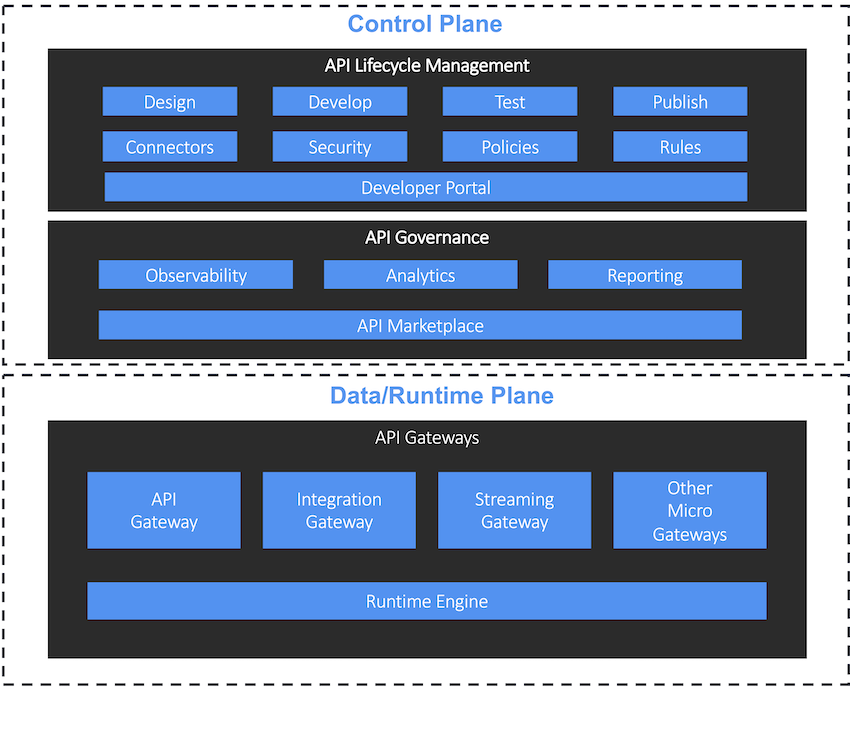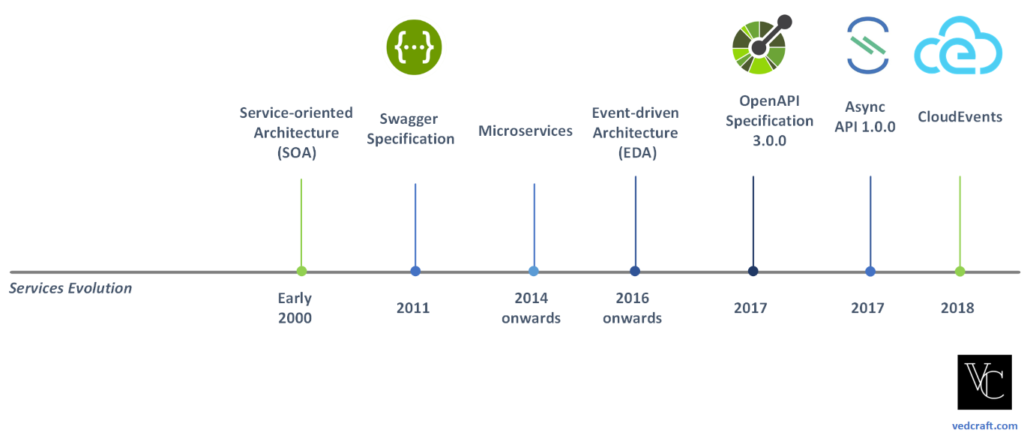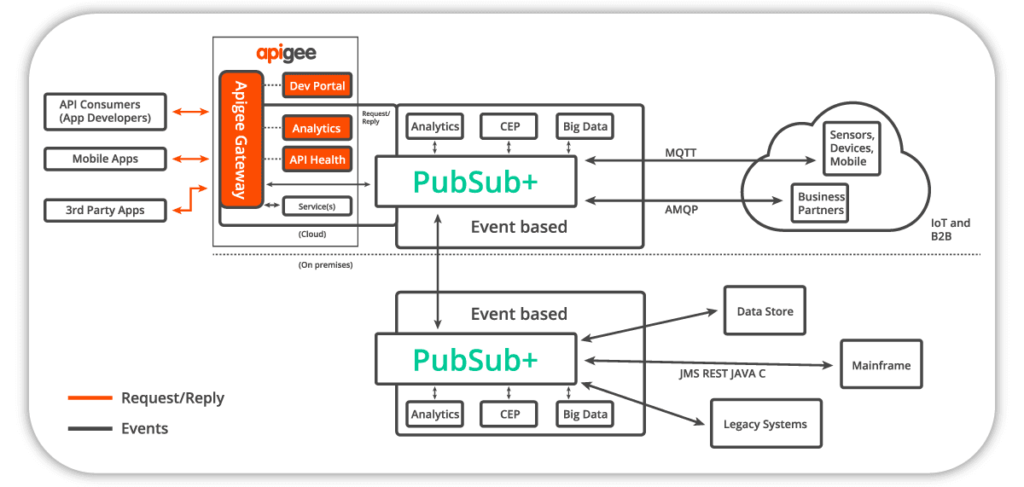With the evolution of enterprise application integration, APIs are the most common interface to exposing functionalities to the wider ecosystem. The rise of Open Banking APIs for financial services, Open APIs in telecommunications, retail, and other domains are clear indicators that integration is not limited within an enterprise. Observing the technology trends in API management helps to extend the enterprise capabilities further, and opens up new possibilities. This article is an opinionated view about the technology trends and updates to know in API management ecosystem covering four different broader areas — API Strategy and Innovation, API Development and Testing, Convergence of architecture patterns, and Emerging API Tools & Technologies.
1. API Strategy and Innovation
There is a paradigm shift in the short-term and long-term strategy being adopted by established players as they are challenged by emerging players. Key trends observed from the strategy and innovation perspective are:
Listen and respond as per the customer’s expectations
Newmarket offerings, better engagement models, and newer pricing models are trending and the customer’s expectations to respond quickly is the need of the hour. Most of the API management platforms have responded by prioritizing their innovation strategy and aligning their roadmaps accordingly.
Pay-as-you-go Pricing model with SaaS offering (using Cloud as an enabler) and supporting new patterns in hybrid-cloud deployment model are key examples of strategic change by API management solutions. These are a summary of key announcements by major players:
- MuleSoft — Extending Anypoint platform (their offering as a centralized offering for APIs and integration) has recently launched capabilities such as Anypoint Flex Gateway as an ultrafast API gateway for Hybrid-cloud, Anypoint API Governance for operationalizing governance, Anypoint Datagraph for GraphQL APIs, and Connectors-based architecture to support third-party integration.
- Apigee — Launched Apigee X as a new Apigee SaaS platform, which integrates with Google’s Cloud Armor firewall and its Cloud Identity Access Management platform. With Apigee hybrid for hybrid-cloud deployment model, AI-Ops enabled API monitoring, and Microservices support with Istio and Envoy, Apigee has been continuously evolving its product ecosystem.
- IBM API Connect, Kong Gateway, Boomi, and WSO2 API Manager have also evolved their product line to support emerging patterns.
- AWS API Gateway and Azure API Management have also started offering hybrid and multi-cloud API management solutions and are being considered a great alternative option when using respective cloud-native services.
Adoption of emerging patterns and technologies
In order to keep abreast with emerging technologies, established players are re-engineering their products to meet the modern needs such as:
- Universal API Management: To govern API deployed across a multi-cloud environment in an enterprise — not only limited to APIs built using the API management platform but also extending the boundary to import APIs from another platform as an integrated platform.
- API Marketplace: To create a global API catalog for API discovery — not just at the company level but also at the global level for discovering third-party APIs and reusability & quicker integration.
- Integrated Platform: Extending beyond REST APIs to support GraphQL-enabled aggregation layer APIs, Event-based APIs, gRPC support, and much more in a consolidated platform providing consistency and ease.
- Pre-built automation for Performance & Security Testing (applying shift-left approach) in the platform itself with lightweight integration channels.
- Cloud-driven Enterprise Integration Platform-as-a-Service (EiPaaS) as a reference architecture is also making the architecture consistent across the different vendor products (see below).
Gartner defines EiPaaS as:
“A combination of integration technology functionalities that are delivered as a suite of cloud services and designed to support enterprise-class integration initiatives

2. API Development and Testing
Focus on developers to accelerate API development and testing has been the key theme by all major players. Extending the developer-focused approach to support has enabled the following:
- Standards-based API Development — Using OpenAPI for REST-based API development and support for Async API for event-driven APIs is the consistent trend observed across the market players.

- API Discovery — As the enterprise application integration is the most common development API developers perform, supporting the developers by providing the newer and enhanced API discovery mechanisms is one of the interesting offerings by emerging players. RapidAPI Enterprise Hub, SwaggerHub, and Postman API Directory are great examples of how these platforms help developers to discover APIs offered by various third-party systems in an easy and user-friendly manner.
- API Documentation — Simplifying API documentation to help developers become more productive has been a key focus area. New approaches are emerging such as using Markdown-based API documentation to help developers use the common language for documentation. For example — MkDocs, which is a Markdown-based static site generator can be used in combination for instructions and general documentation (OpenML is using MkDocs + Swagger as a combination for their API documentation). Swagger — a de facto standard for generating, visualizing, and maintaining API docs. Swagger UI can be easily white-labeled and customized as per your organization’s needs. Click here for a live demo of the Petstore application.
3. Convergence of architecture patterns
API management and related architecture patterns such as API Gateway is reshaping itself to be a collaborative technology than a competitive one. Key areas architectural patterns are converging are:
Event-driven Architecture
APIs are considered to be request/response model-driven supporting synchronous communication as the primary underlying communication approach. While event-driven architecture and related solutions (such as Event Mesh) can be considered as an alternative approach to integration, they can be considered as a collaborative architecture pattern with:
- Outside communication — APIs being used for external interface to the system supporting synchronous communication for consumers to avoid the complexity of handling error scenarios and end user’s expectations of request/response based simple communication.
- Internal communication — Event-driven approach being used for internal microservices communication than the synchronous approach using Event Mesh or similar publisher/subscriber technology.
A solution like Solace PubSub+ Platform offers an integrated solution with API management providers (MuleSoft, Apigee) to provide the integrated offering as represented below (with Apigee handling synchronous API management and analytics, and PubSub+ enabling asynchronous pub/sub communications):

Service Mesh
- The emergence of an integrated solution offering with API Gateway and service mesh — Solo.io offers Gloo Mesh Enterprise (built using Istio), which provides GraphQL, Service Mesh, API Gateway, and WebAssembly as an integrated offering. It uses Envoy-based API Gateway with GraphQL, Web Assembly & eBPF support (Gloo Edge) with Service Mesh (Gloo Mesh) as a foundational technology.
4. Emerging API Tools & Technologies
With emerging technologies (eBPF, GraphQL, etc.) and cloud-native architecture, there are new players with innovative offerings. Here are a few interesting observations:
- RapidAPI — brainstormed in a Hackathon and started as API Marketplace and now has 3M+ developers accessing more than 30K+ APIs.
- ReadyAPI (by SmartBear, the company behind products Swagger, and SoapUI) — offers to create, manage, and execute automated functional, security, and performance tests in one centralized interface.
- Apollo GraphQL — A well-established player in the GraphQL platform (challenger for API Gateway) coming up with solutions like Apollo Router, a configurable, high-performance graph router for a federated supergraph.
- Hasura — GraphQL-focused cloud-native API development platform for accelerating development directly from the database to GraphQL APIs.
- Wundergraph — Serverless API building developer platform with integration with NextJS & Svelte, and server-side compile-time GraphQL.
- Postman — focused on SaaS offering with a focus on API design & testing and added Asynchronous APIs and GraphQL APIs testing capabilities.
- Kusk — Uses OpenAPI specifications to generate Kubernetes manifest.
- OpenAPI Generator — Generate clients, servers, and documentation from OpenAPI 2.0/3.x documents.
- AsyncAPI Generator — Generate documentation, code, and more out of your AsyncAPI files.
To conclude, the API management ecosystem is going through an evolutionary architecture stage and with new players, we are going to observe new patterns, solution offerings, and new ways of building APIs. Keep watching up this space to know more!
Disclaimer:
All data and information provided on this blog are for informational purposes only. This makes no representations as to the accuracy, completeness, correctness, suitability, or validity of any information on this site and will not be liable for any errors, omissions, or delays in this information or any losses, injuries, or damages arising from its display or use. All information is provided on an as-is basis. This is a personal opinion. The opinions expressed here represent my own and not those of my employer or any other organization.

